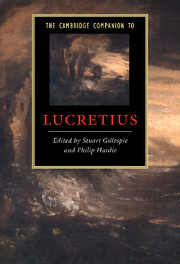Book contents
- Frontmatter
- Introduction
- Part I: Antiquity
- Part II: Themes
- 8 Lucretius and the history of science
- 9 Moral and political philosophy: readings of Lucretius from Virgil to Voltaire
- 10 Lucretius and the sublime
- 11 Religion and enlightenment in the neo-Latin reception of Lucretius
- Part III: Reception
- Dateline
- List of works cited
- Index of Main Lucretian Passages Discussed
- General Index
10 - Lucretius and the sublime
from Part II: - Themes
Published online by Cambridge University Press: 28 May 2010
- Frontmatter
- Introduction
- Part I: Antiquity
- Part II: Themes
- 8 Lucretius and the history of science
- 9 Moral and political philosophy: readings of Lucretius from Virgil to Voltaire
- 10 Lucretius and the sublime
- 11 Religion and enlightenment in the neo-Latin reception of Lucretius
- Part III: Reception
- Dateline
- List of works cited
- Index of Main Lucretian Passages Discussed
- General Index
Summary
Is Lucretius a crucial link in the history of the sublime? The suspicion has been mooted in the past, though opinions vary as to where to place the accent (style and genre are the two contenders). A fuller exploration of Lucretius’ relationship to the sublime can shed light on much of his poetry, on his deepest insights into atomism and on his place in the ancient and modern worlds. To see how this is so, three kinds of connection need to be drawn: between Lucretius and Longinus; between both of these and their intellectual forebears; and between Lucretius and the greatest modern philosopher of the sublime, Kant. But as these connections are not commonly made, a few preliminary justifications will be necessary.
Defining the sublime
At any historical moment the sublime is hard if not impossible to define. After all, in the early modern period it was rebaptised as the je ne sais quoi, or ‘I haven’t got a clue’, reflecting a sense of its ineffability or perhaps the sheer frustration of trying to pin down its ancient and modern meanings. The only surviving author from classical antiquity to develop a language for naming and treating the sublime, known today as Longinus, wrote a treatise of uncertain date (usually placed in the first century bc) Peri Hypsous - On Height, or On the Sublime. However, Longinus was by no means the first to deploy the concept of the sublime, as he himself tells us.
- Type
- Chapter
- Information
- The Cambridge Companion to Lucretius , pp. 167 - 184Publisher: Cambridge University PressPrint publication year: 2007
- 19
- Cited by

